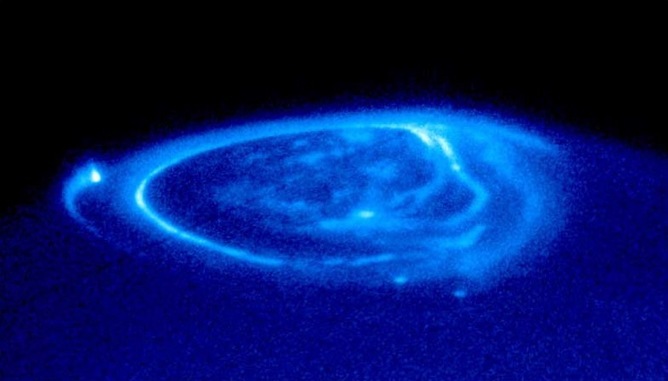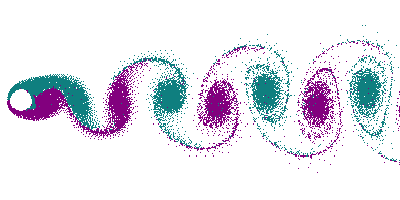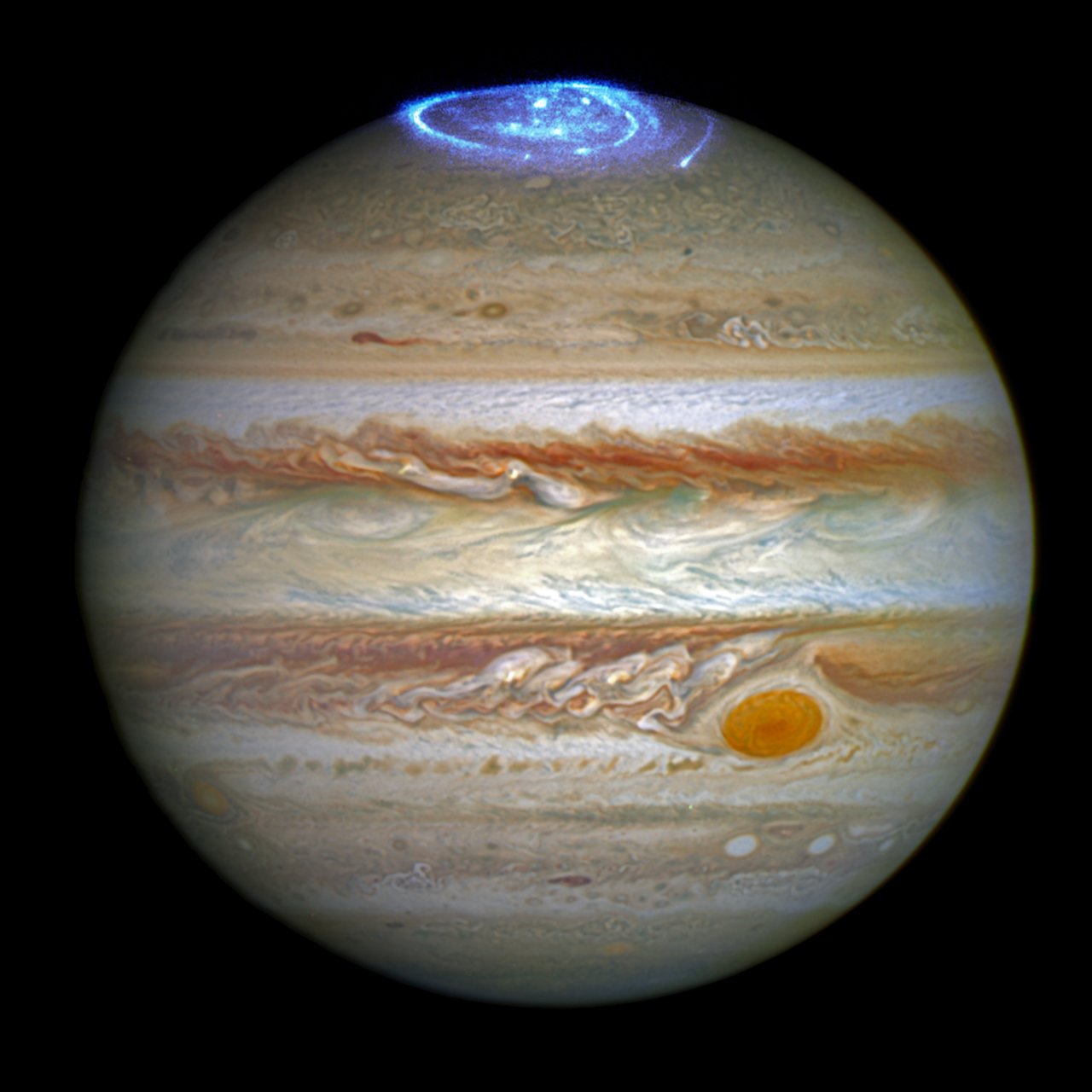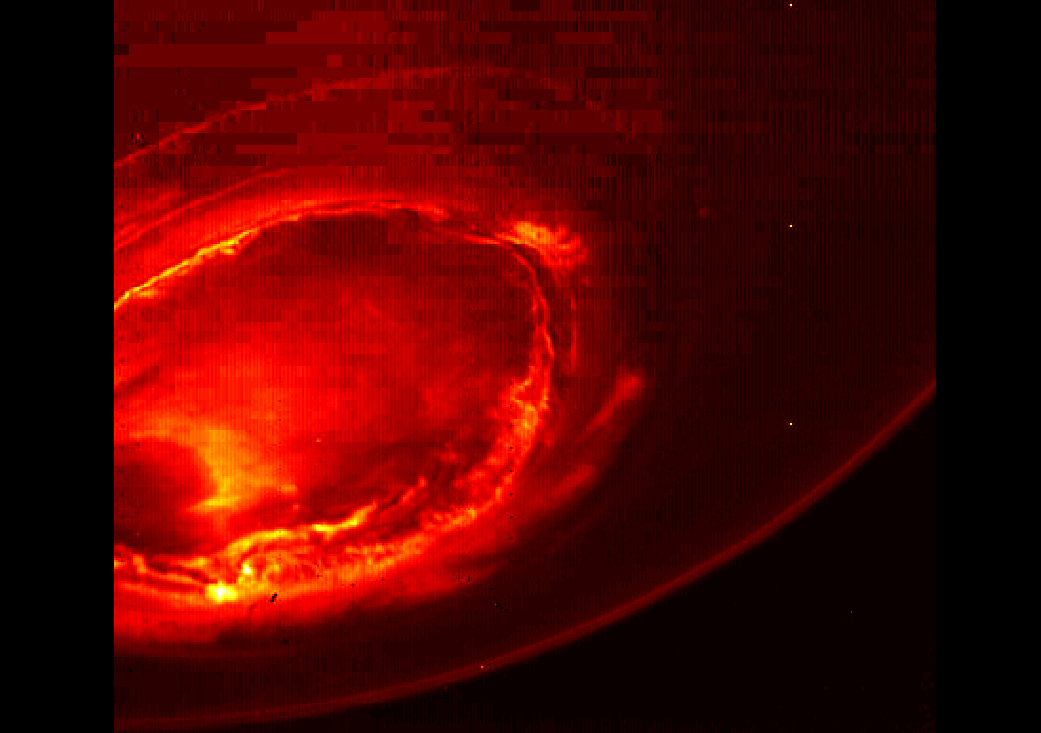Jupiter's Moons Spin Intricate Auroras at Planet's Poles

New research shows the closest-ever views of features in Jupiter's swirling auroras, revealing the complicated footprints left by its moons Io and Ganymede.
As Jupiter's moons orbit close over the gas giant, they interact with its powerful magnetic field, influencing the electron auroras that form at the planet's poles. The Hubble Space Telescope has imaged the bright dots and trails left by each of the four Galilean moons as they pass by — the footprint of the farthest moon, Callisto, was finally pinned down this year. But Hubble's (and Earth's) view of Jupiter makes it hard to clearly see the planet's poles, and its distance doesn't allow a good-enough resolution — so to dig deeper into those footprints, scientists needed a different perspective.
Enter NASA's Juno spacecraft, currently orbiting Jupiter and giving researchers their closest look at the gas giant. New images from Juno's Jovian Infrared Auroral Mapper (JIRAM) instrument are revealing that the moons' auroral footprints are much more complicated, and tailored to the individual moons, than previously thought. [In Photos: Juno's Amazing Views of Jupiter]
Swirls behind Io
As Jupiter's moons pass through the charged particles called plasma that surrounds it, researchers think the plasma interacts with Jupiter's magnetic field to spark features in the planet's electron auroras. Those auroras aren't visible to the naked eye, but can be picked up by infrared and ultraviolet sensors.
Juno swings by Jupiter's poles every two months, giving Juno's aurora-mapper instrument the chance to observe the auroras up close for about an hour.
"During Orbit 8 [in] September of 2017, we decided to look close, very, very close to the footprint of Io," Alessandro Mura, lead author on the new work and a researcher at the National Institute for Astrophysics in Italy, told Space.com. "We were not expecting anything special, because so far there was no particular reason why to expect anything different than a big spot."
But what they did find was surprising: Rather than one big spot, the volcanic moon Io generates a pattern of vortices swirling off the footprint's "tail," resembling the swirls that form when a cylindrical object passes through a fluid.
Get the Space.com Newsletter
Breaking space news, the latest updates on rocket launches, skywatching events and more!
"The discovery of the footprint itself is not new, it is that we now see how they are shaped — and the shape is very, very strange," Mura said.

The pattern streaks for hundreds of kilometers after the moon passes by, leaving a spot on an alternating side about every 62 miles (100 km), for 10 or more spots. Mura noted that it's simply a physical resemblance to that fluid dynamics pattern at this point — researchers don't have the models yet to explain why Io traveling through Jupiter's magnetic field would spark that particular pattern.
"Io, being the closest [moon to Jupiter], has the most intense footprint," Mura said. "Io is so close that tracing the magnetic field from Io to Jupiter is a very powerful tool to understanding the magnetic field." Jupiter's intense field of plasma, which Io seems to contribute to, also plays a role in the imprint.

Doubled-up at Ganymede
And when they investigated the footprint of the moon Ganymede, the researchers saw something unusual as well: rather than one spot, they saw two separated by about 100 km — a never-before-seen double footprint.
That feature probably reflects something unique about the moon, Mura said: "There's only one moon which has its own magnetic field, which is Ganymede."
At "Ganymede, what we're seeing is not the interaction of the moon itself with the plasma of Jupiter," he added. "We are seeing the interaction of the magnetosphere of Jupiter inside another magnetosphere."
And as Io's complicated footprint gives researchers a rare chance to better understand the moon's interactions with the plasma around Jupiter, Ganymede's gives a key observation opportunity as well: "This is the first time we can have an image of the size of the magnetosphere of Ganymede by looking to its projection on top of Jupiter," Mura said.

Lucky break
Mura said that getting more data from the auroras — including analyzing the footprints of other Galilean moons — is the easy part of future research. After all, Juno is already set to pass over Jupiter's poles for many more orbits, providing plenty of opportunity for analysis.
"But one important thing is that we are refining our pointing," Mura said. "Because actually, the footprints are not exactly the place that we expected them, because the magnetic field models have to be improved."
"The chance we had to observe the Io footprint was very lucky, because we caught both of them during the first shot during Orbit 8… the chances were that we could miss the footprint by, say, 1,000 km [600 miles]," he added. "Now that we have better models and better understanding, we can try to have even better images." And those images will tell researchers more about the great gas giant as well as the moons that pass through its magnetic field.
The new work was detailed today(July 5) in the journal Science.
Email Sarah Lewin at slewin@space.com or follow her @SarahExplains. Follow us @Spacedotcom, Facebook and Google+. Original article on Space.com.
Join our Space Forums to keep talking space on the latest missions, night sky and more! And if you have a news tip, correction or comment, let us know at: community@space.com.

Sarah Lewin started writing for Space.com in June of 2015 as a Staff Writer and became Associate Editor in 2019 . Her work has been featured by Scientific American, IEEE Spectrum, Quanta Magazine, Wired, The Scientist, Science Friday and WGBH's Inside NOVA. Sarah has an MA from NYU's Science, Health and Environmental Reporting Program and an AB in mathematics from Brown University. When not writing, reading or thinking about space, Sarah enjoys musical theatre and mathematical papercraft. She is currently Assistant News Editor at Scientific American. You can follow her on Twitter @SarahExplains.









